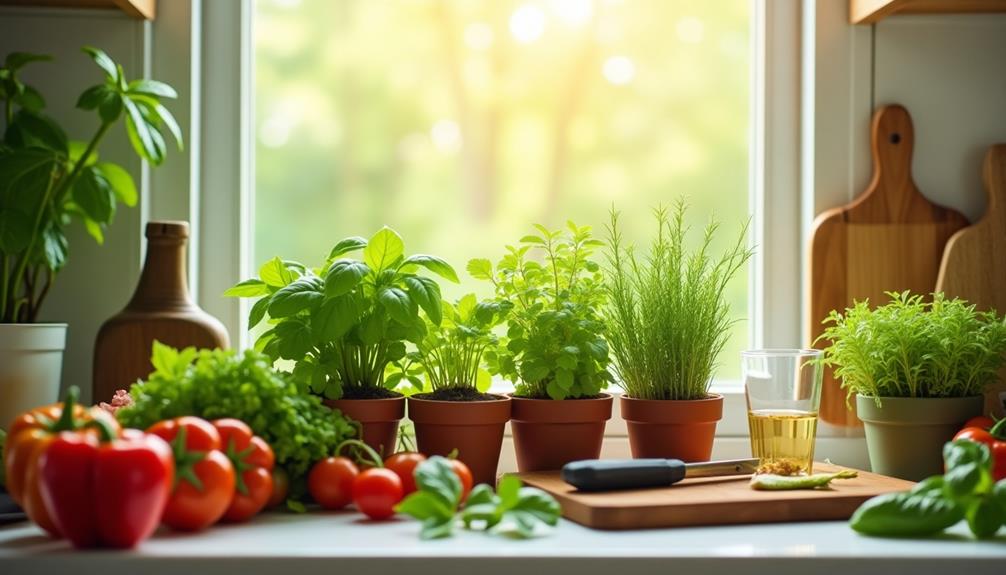Imagine the vibrant green leaves of basil, parsley, and thyme nestled within easy reach on your kitchen counter, ready to elevate your meals. You might wonder how to cultivate these herbs effectively in your home, ensuring they add freshness and flavor to your dishes. Selecting the right varieties, understanding their light and water needs, and knowing how to care for them can make all the difference. As you consider these factors, you might find yourself contemplating the best strategies for a thriving herb garden right in your own kitchen.
Choosing the Right Herbs

When selecting herbs for your kitchen counter, consider your cooking habits and personal taste. Think about the dishes you love to prepare and the flavors that elevate them. For instance, if you enjoy Italian cuisine, basil and oregano might be top choices, while cilantro and mint can enhance your favorite Mexican or Middle Eastern recipes.
Next, familiarize yourself with herb flavor profiles. Each herb has a distinct taste that can complement or overpower your dishes. For example, rosemary offers a robust flavor, making it perfect for roasted meats, while chives provide a mild onion taste that works well in salads and dressings.
Don't forget about seasonal herb selection. Some herbs thrive in specific seasons, so plan accordingly. In spring and summer, you might find yourself drawn to fresh basil and parsley, while winter can bring heartier herbs like thyme and sage.
Selecting Containers and Pots
Selecting the right containers and pots is crucial for growing herbs on your kitchen counter. You'll want to consider both container materials and pot sizes to create the best environment for your herbs.
Start with materials. Clay pots are great because they're breathable, allowing for proper drainage, but they can dry out quickly. Plastic containers, on the other hand, retain moisture better and are lightweight, making them easy to move. Whichever material you choose, ensure there are drainage holes to prevent waterlogging.
Next, think about pot sizes. For most kitchen herbs, small to medium pots—around 6 to 10 inches in diameter—work well. These sizes allow for adequate root growth without taking up too much counter space. If you're growing multiple herbs together, opt for larger containers that can accommodate their root systems.
Lastly, consider the aesthetic appeal of your pots. Choose containers that complement your kitchen decor while being functional.
Optimal Lighting Conditions
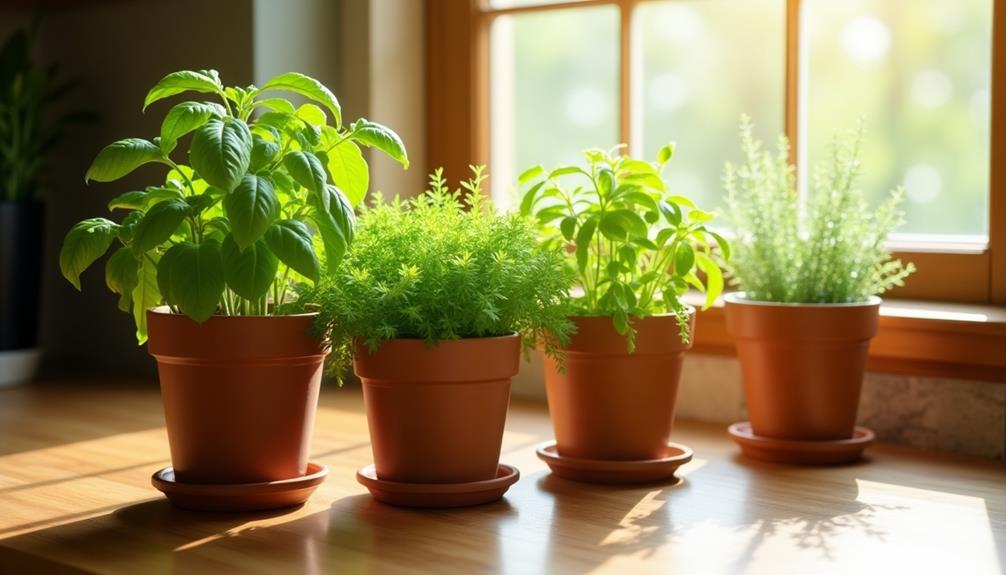
Proper lighting is essential for successful herb growth on your kitchen counter. Without the right light intensity, your herbs can become leggy or fail to thrive. Ideally, you want your herbs to receive at least six hours of natural sunlight each day. If your kitchen windows don't allow enough light in, consider supplementing with grow lights, which can mimic natural sunlight.
When selecting a spot for your herbs, choose a south-facing window if possible, as it typically offers the best light conditions. Pay attention to how the light changes throughout the day; some areas might receive morning sun but be shaded in the afternoon.
If you notice your herbs leaning toward the light, they're likely not getting enough intensity, so consider rotating them or adjusting their position.
Keep in mind that different herbs have varying light needs. For instance, basil and parsley thrive in bright light, while mint can tolerate slightly lower conditions.
Monitor your herbs closely, and if they show signs of stress, reassess their lighting situation. With the right lighting setup, you'll encourage robust growth and flavorful herbs right in your kitchen.
Soil and Drainage Needs
For your herbs to flourish on the kitchen counter, the right soil and drainage are crucial. Start by choosing the appropriate soil types. A well-draining potting mix is ideal, as it provides the nutrients your herbs need while preventing water from pooling around the roots. Look for a blend that contains peat moss, vermiculite, or perlite; these materials help retain moisture without suffocating your plants.
Next, focus on drainage materials. Ensure your pots have drainage holes to allow excess water to escape. If you're using a container without holes, consider adding a layer of small stones or gravel at the bottom. This layer promotes drainage and keeps the soil from becoming overly saturated.
Mixing in materials like sand or perlite into your potting mix can also improve drainage. It's essential to strike a balance between moisture retention and drainage; too much moisture can lead to root rot, while too little can dry out your herbs too quickly.
Watering Techniques
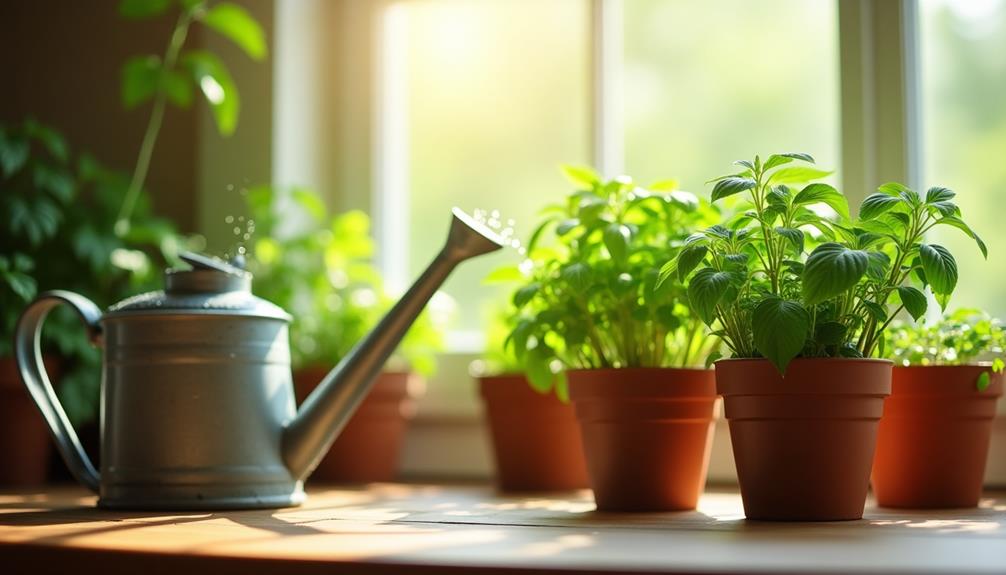
When it comes to watering your kitchen herbs, finding the right balance is key.
You'll want to consider how often you water, ensure proper drainage, and watch for signs of overwatering that can harm your plants.
Let's explore these essential techniques to keep your herbs thriving.
Optimal Watering Frequency
To keep your herbs thriving on the kitchen counter, understanding the optimal watering frequency is crucial. You'll want to establish a consistent watering schedule that maintains the right level of herb moisture without overdoing it. Most kitchen herbs prefer slightly moist soil, so check them regularly.
A good rule of thumb is to water when the top inch of soil feels dry. This usually translates to watering every 5 to 7 days, but it can vary based on factors like temperature, humidity, and the type of herbs you're growing. For instance, basil might need more frequent watering than rosemary.
When you do water, give your herbs a thorough soak, allowing the water to penetrate deep into the roots. Avoid letting them sit in water, as this can lead to root rot.
If you notice the leaves wilting or turning yellow, it may indicate that you're either underwatering or overwatering. By keeping a close eye on your herbs and adjusting your watering schedule as needed, you'll ensure they flourish and enhance your culinary creations.
Drainage Considerations
How can you ensure proper drainage for your kitchen herbs? The key is to use effective drainage materials and solutions that prevent water from pooling at the bottom of your pots.
Start by choosing pots with drainage holes. If your pots don't have them, consider using a drill to create some. This simple step helps excess water escape, keeping your herbs' roots healthy.
Next, add a layer of drainage materials at the bottom of the pot. Options like gravel, pebbles, or expanded clay pellets can help facilitate water flow. They create space for excess moisture to collect, reducing the risk of root rot.
When you pot your herbs, you can also mix in materials like perlite or vermiculite with your potting soil. These drainage solutions improve aeration and drainage while retaining some moisture.
Lastly, be mindful of how much you water. While it's tempting to give your herbs plenty of water, overwatering can lead to serious issues, even with the best drainage methods.
Signs of Overwatering
Recognizing the signs of overwatering is vital for keeping your kitchen herbs healthy. If you notice yellowing leaves, that's often your first clue. Those leaves may also feel soft and mushy, indicating that your herbs are drowning.
Another red flag is a foul smell coming from the soil, which can signal herb root rot.
To prevent these issues, consider using a moisture meter. This handy tool can help you gauge the soil's moisture levels more accurately than a simple finger test. If the moisture meter indicates wet soil when you think it should be dry, it's time to cut back on watering.
Additionally, check for condensation on the inner sides of your pots or trays. Excessive moisture can lead to mold growth, which is another sign that you may be overwatering.
Fertilizing Your Herbs
When it comes to fertilizing your herbs, many growers overlook this crucial step, believing that their plants can thrive on sunlight and water alone. However, to meet their herb nutrient requirements, you'll need to add some nutrients to the mix.
Herbs in containers, especially, can deplete the soil quickly, making regular fertilization essential for healthy growth.
You have several organic fertilizer options to consider. Compost is an excellent choice, as it provides a slow-release source of nutrients while improving soil structure.
You might also opt for liquid organic fertilizers, which can be diluted and applied monthly during the growing season. Look for options containing seaweed or fish emulsion for added benefits.
When fertilizing, remember that less is often more. Over-fertilizing can lead to lush foliage with diminished flavor, which is the last thing you want.
Start with a light application, observing how your herbs respond, and adjust as needed. Keep in mind that each herb has slightly different nutrient needs, so tailor your approach based on the specific varieties you're growing.
With the right care, your kitchen herbs will flourish, providing fresh flavors for your culinary creations.
Pruning and Harvesting Tips
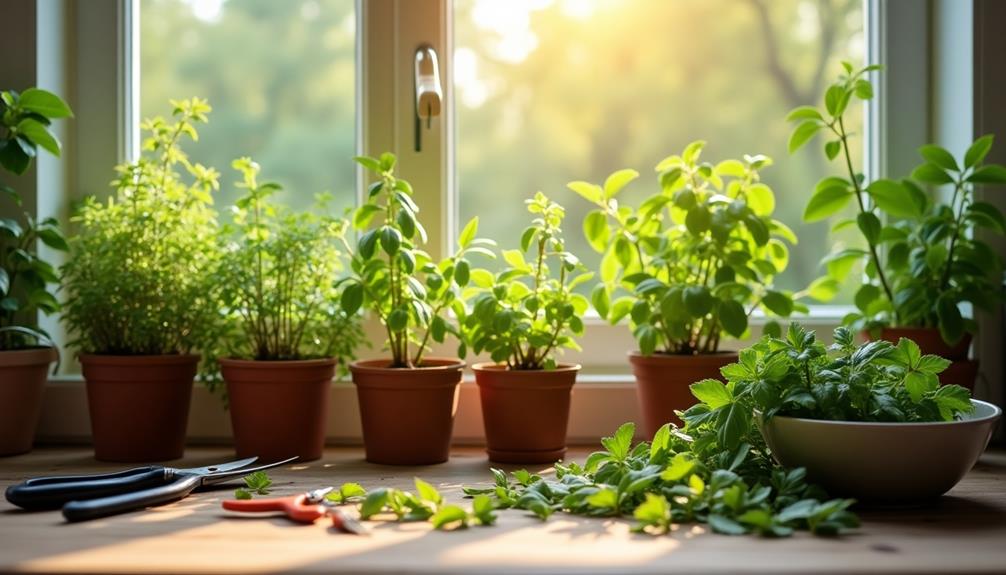
Pruning and harvesting your herbs regularly not only encourages healthy growth but also enhances their flavor. Start by using proper pruning techniques, which involve cutting just above a leaf node. This stimulates new growth and keeps your plants bushy. For herbs like basil, don't be afraid to pinch off the top leaves; this encourages the plant to develop a fuller shape.
When it comes to harvesting methods, aim to pick your herbs in the morning when their essential oils are at their peak. Use clean, sharp scissors or garden shears to avoid damaging the plant. For leafy herbs like cilantro and parsley, snip off outer leaves first; this allows the inner leaves to continue growing.
For woody herbs like rosemary, harvest sprigs as needed, taking care not to remove more than one-third of the plant at a time.
Remember to avoid over-harvesting, as this can weaken the plant. By following these pruning techniques and harvesting methods, you'll enjoy a bountiful supply of fresh herbs right from your kitchen counter, enhancing your meals and adding flavor to your cooking.
Common Pests and Solutions
Many kitchen herb growers encounter pests that can threaten their plants' health and vibrancy. Common culprits include aphids, spider mites, and whiteflies. These pests not only suck the sap from your herbs but can also introduce herb diseases that hinder growth.
It's crucial to act fast when you notice signs of infestation. To prevent these pests, maintain good air circulation and avoid overwatering, as damp conditions can attract unwanted visitors. Regularly inspect your herbs for any signs of pests, such as discolored leaves or webbing.
If you spot an infestation, you can use insecticidal soap or neem oil as effective solutions. Just be sure to apply them in the early morning or late evening to avoid harming beneficial insects.
You can also introduce natural predators like ladybugs or lacewings, which can help keep pest populations in check. By implementing these pest prevention strategies, you'll reduce the risk of infestations and keep your herbs thriving.
Creative Kitchen Counter Arrangements
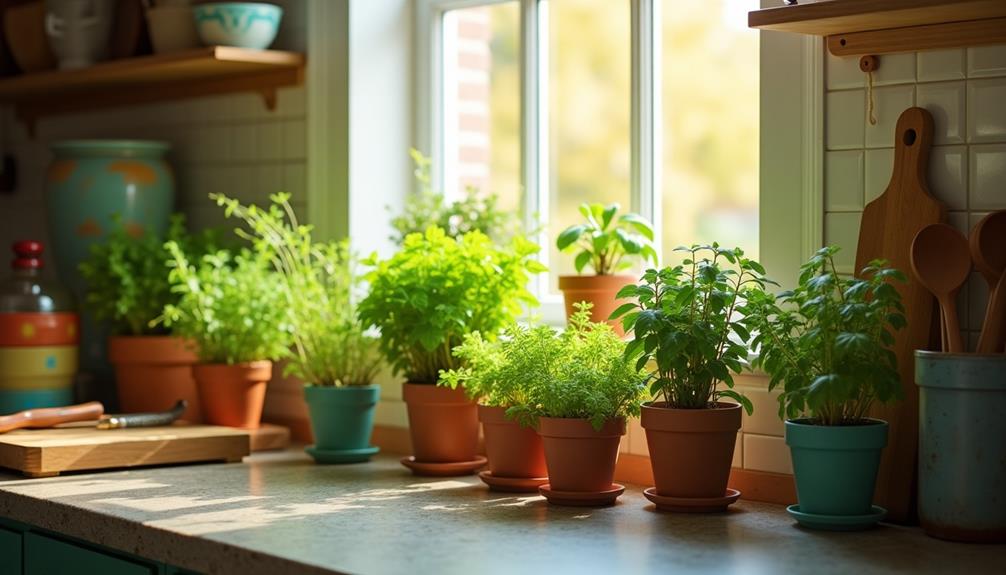
If you want to maximize your kitchen space, consider vertical garden options that add both style and functionality.
Choosing the right containers can enhance your herb display while keeping them easily accessible.
Let's explore some creative arrangements that can transform your counter into a vibrant herb haven.
Vertical Garden Options
For those looking to maximize space and style in their kitchen, vertical gardens offer a fantastic solution. By incorporating a vertical garden, you can create a stunning green display while efficiently using limited counter space.
Wall mounted planters are a great option, allowing you to hang your herbs on the wall, keeping them within reach while freeing up your countertop. You can easily access your fresh herbs when cooking, adding a touch of flair to your kitchen.
If you're feeling adventurous, consider hydroponic systems. These innovative setups let you grow herbs without soil, using nutrient-rich water instead. They often come in sleek designs that not only save space but also add a modern vibe to your kitchen.
You can find hydroponic kits that fit snugly against the wall or even those with built-in lighting to enhance growth.
When choosing your vertical garden options, think about your available wall space and the amount of sunlight your herbs will need.
With a bit of planning and creativity, you can transform your kitchen into a lush herb haven that's both functional and visually appealing.
Stylish Container Choices
When it comes to growing herbs on your kitchen counter, choosing the right containers can elevate both functionality and aesthetics. You want your herb container aesthetics to complement your kitchen's style, so consider materials that not only look good but are also sustainable.
Ceramic pots are a popular choice; they're durable and come in a variety of colors and designs. If you prefer something more modern, opt for glass or metal containers—these can add a sleek touch while showcasing the beauty of your herbs. Recycled materials can also serve as unique containers, giving your herbs a stylish home while being eco-friendly.
Think about arranging your herbs in a tiered stand or hanging containers to save space and create visual interest. This not only maximizes your kitchen counter but also makes it easy to access your favorite herbs when cooking.
Don't forget to ensure proper drainage for your plants, as healthy herbs are the key to a vibrant kitchen. With these stylish container choices, you'll create an inviting and functional herb garden right on your countertop.
Enjoying Fresh Herb Recipes
Incorporating fresh herbs into your cooking elevates flavors and adds a vibrant touch to your meals. Whether you're whipping up a simple salad or a hearty main dish, herbs can transform your culinary experience.
Start by making fresh herb dressings; just blend your favorite herbs with olive oil, vinegar, and a pinch of salt. You'll create a delicious dressing that enhances any salad or grilled vegetable.
You can also experiment with herb-infused oils. Simply combine your fresh herbs with olive oil in a jar, let them steep for a week, and you'll have a flavorful oil to drizzle over dishes, use for sautéing, or as a dip for bread.
Don't forget about using herbs in marinades! Combine herbs with garlic, lemon juice, and your protein of choice for a fresh, aromatic flavor.
Try adding herbs to your roasted vegetables or sprinkle them over pasta dishes to brighten the flavors.

